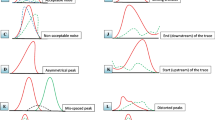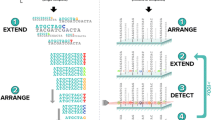Abstract
The ability to provide accurate DNA-based forensic intelligence requires analysis of multiple DNA markers to predict the biogeographical ancestry (BGA) and externally visible characteristics (EVCs) of the donor of biological evidence. Massively parallel sequencing (MPS) enables the analysis of hundreds of DNA markers in multiple samples simultaneously, increasing the value of the intelligence provided to forensic investigators while reducing the depletion of evidential material resulting from multiple analyses. The Precision ID Ancestry Panel (formerly the HID Ion AmpliSeq™ Ancestry Panel) (Thermo Fisher Scientific) (TFS)) consists of 165 autosomal SNPs selected to infer BGA. Forensic validation criteria were applied to 95 samples using this panel to assess sensitivity (1 ng-15 pg), reproducibility (inter- and intra-run variability) and effects of compromised and forensic casework type samples (artificially degraded and inhibited, mixed source and aged blood and bone samples). BGA prediction accuracy was assessed using samples from individuals who self-declared their ancestry as being from single populations of origin (n = 36) or from multiple populations of origin (n = 14). Sequencing was conducted on Ion 318™ chips (TFS) on the Ion PGM™ System (TFS). HID SNP Genotyper v4.3.1 software (TFS) was used to perform BGA predictions based on admixture proportions (continental level) and likelihood estimates (sub-population level). BGA prediction was accurate at DNA template amounts of 125pg and 30pg using 21 and 25 PCR cycles respectively. HID SNP Genotyper continental level BGA assignments were concordant with BGAs for self-declared East Asian, African, European and South Asian individuals. Compromised, mixed source and admixed samples, in addition to sub-population level prediction, requires more extensive analysis.









Similar content being viewed by others
References
Kayser M, de Knijff P (2011) Improving human forensics through advances in genetics, genomics and molecular biology. Nat Rev Genet 12(3):179–192. https://doi.org/10.1038/nrg2952
Pardo-Seco J, Martinón-Torres F, Salas A (2014) Evaluating the accuracy of AIM panels at quantifying genome ancestry. BMC Genomics 15(1):1–24. https://doi.org/10.1186/1471-2164-15-543
Fondevila M, Phillips C, Santos C, Aradas AF, Vallone P, Butler J, Lareu M, Carracedo A (2013) Revision of the SNPforID 34-plex forensic ancestry test: assay enhancements, standard reference sample genotypes and extended population studies. Forensic Sci Int: Genet 7(1):63–74. https://doi.org/10.1016/j.fsigen.2012.06.007
Halder I, Shriver M, Thomas M, Fernandez JR, Frudakis T (2008) A panel of ancestry informative markers for estimating individual biogeographical ancestry and admixture from four continents: utility and applications. Hum Mutat 29(5):648–658. https://doi.org/10.1002/humu.20695
Kidd JR, Friedlaender FR, Speed WC, Pakstis AJ, De La Vega FM, Kidd KK (2011) Analyses of a set of 128 ancestry informative single-nucleotide polymorphisms in a global set of 119 population samples. Investig Genet 2(1):1. https://doi.org/10.1186/2041-2223-2-1
Kidd KK, Speed WC, Pakstis AJ, Furtado MR, Fang R, Madbouly A, Maiers M, Middha M, Friedlaender FR, Kidd JR (2014) Progress toward an efficient panel of SNPs for ancestry inference. Forensic Sci Int: Genet 10:23–32. https://doi.org/10.1016/j.fsigen.2014.01.002
Kosoy R, Nassir R, Tian C, White PA, Butler LM, Silva G, Kittles R, Alarcon-Riquelme ME, Gregersen PK, Belmont JW, De La Vega FM, Seldin MF, och p I f g, farmaceutiska v M o, Medicinska f U u (2009) Ancestry informative marker sets for determining continental origin and admixture proportions in common populations in America. Hum Mutat 30(1):69–78. https://doi.org/10.1002/humu.20822
Nassir R, Kosoy R, Tian C, White PA, Butler LM, Silva G, Kittles R, Alarcon-Riquelme ME, Gregersen PK, Belmont JW, De La Vega FM, Seldin MF (2009) An ancestry informative marker set for determining continental origin: validation and extension using human genome diversity panels. BMC Genet 10(1):39. https://doi.org/10.1186/1471-2156-10-39
Thermo Fisher Scientific (2015) Ion AmpliSeq™ library preparation for human identification applications. Thermo Fisher Scientific Inc., Carlsbad
Eduardoff M, Santos C, de la Puente M, Gross TE, Fondevila M, Strobl C, Sobrino B, Ballard D, Schneider PM, Carracedo Á, Lareu MV, Parson W, Phillips C (2015) Inter-laboratory evaluation of SNP-based forensic identification by massively parallel sequencing using the Ion PGM™. Forensic Sci Int: Genet 17:110–121. https://doi.org/10.1016/j.fsigen.2015.04.007
Seo SB, King JL, Warshauer DH, Davis CP, Ge J, Budowle B (2013) Single nucleotide polymorphism typing with massively parallel sequencing for human identification. Int J Legal Med 127(6):1079–1086. https://doi.org/10.1007/s00414-013-0879-7
Daniel R, Santos C, Phillips C, Fondevila M, van Oorschot RA, Carracedo A, Lareu MV, McNevin D (2015) A SNaPshot of next generation sequencing for forensic SNP analysis. Forensic Sci Int: Genet 14:50–60. https://doi.org/10.1016/j.fsigen.2014.08.013
Pereira V, Mogensen HS, Borsting C, Morling N (2017) Evaluation of the Precision ID Ancestry Panel for crime case work: a SNP typing assay developed for typing of 165 ancestral informative markers. Forensic Sci Int Genet 28:138–145. https://doi.org/10.1016/j.fsigen.2017.02.013
Churchill JD, Chang J, Ge J, Rajagopalan N, Wootton SC, Chang CW, Lagace R, Liao W, King JL, Budowle B (2015) Blind study evaluation illustrates utility of the Ion PGM system for use in human identity DNA typing. Croat Med J 56(3):218–229. https://doi.org/10.3325/cmj.2015.56.218
Cox MP, Karafet TM, Lansing JS, Sudoyo H, Hammer MF (2010) Autosomal and X-linked single nucleotide polymorphisms reveal a steep Asian–Melanesian ancestry cline in eastern Indonesia and a sex bias in admixture rates. Proc R Soc Lond B: Biol Sci:rspb20092041
Xu S, Pugach I, Stoneking M, Kayser M, Jin L, Consortium HP-AS (2012) Genetic dating indicates that the Asian–Papuan admixture through Eastern Indonesia corresponds to the Austronesian expansion. Proc Natl Acad Sci 109(12):4574–4579
Tishkoff SA, Williams SM (2002) Genetic analysis of African populations: human evolution and complex disease. Nat Rev Genet 3(8):611–621. https://doi.org/10.1038/nrg865
Castel C (2014) Inference of biogeographical ancestry and pigmentation phenotype using single nucleotide polymorphisms. Doctoral dissertation, University of Technology, Sydney, Australia
Phillips C, Prieto L, Fondevila M, Salas A, Gomez-Tato A, Alvarez-Dios J, Alonso A, Blanco-Verea A, Brion M, Montesino M, Carracedo A, Lareu MV (2009) Ancestry analysis in the 11-M Madrid bomb attack investigation. PLoS One 4(8):e6583. https://doi.org/10.1371/journal.pone.0006583
Mathias RA, Taub MA, Gignoux CR, Fu W, Musharoff S, O'Connor TD, Vergara C, Torgerson DG, Pino-Yanes M, Shringarpure SS, Huang L, Rafaels N, Boorgula MP, Johnston HR, Ortega VE, Levin AM, Song W, Torres R, Padhukasahasram B, Eng C, Mejia-Mejia DA, Ferguson T, Qin ZS, Scott AF, Yazdanbakhsh M, Wilson JG, Marrugo J, Lange LA, Kumar R, Avila PC, Williams LK, Watson H, Ware LB, Olopade C, Olopade O, Oliveira R, Ober C, Nicolae DL, Meyers D, Mayorga A, Knight-Madden J, Hartert T, Hansel NN, Foreman MG, Ford JG, Faruque MU, Dunston GM, Caraballo L, Burchard EG, Bleecker E, Araujo MI, Herrera-Paz EF, Gietzen K, Grus WE, Bamshad M, Bustamante CD, Kenny EE, Hernandez RD, Beaty TH, Ruczinski I, Akey J, Barnes KC (2016) A continuum of admixture in the Western Hemisphere revealed by the African Diaspora genome. Nat Commun 7:12522. https://doi.org/10.1038/ncomms12522
Phillips C, Salas A, Sanchez JJ, Fondevila M, Gomez-Tato A, Alvarez-Dios J, Calaza M, de Cal MC, Ballard D, Lareu MV, Carracedo A, Consortium SN (2007) Inferring ancestral origin using a single multiplex assay of ancestry-informative marker SNPs. Forensic Sci Int: Genet 1(3–4):273–280. https://doi.org/10.1016/j.fsigen.2007.06.008
Portland State University (2012) Geography of the Modern Middle East and North Africa. http://www.middleeastpdx.org/resources/original/geography-of-the-modern-middle-east-and-north-africa/. Accessed 08 Nov 2015
Worldatlas.com (2015) Middle East. http://www.worldatlas.com/webimage/countrys/me.htm. Accessed 08 Nov 2015
Thermo Fisher Scientific (2016) HID SNP Genotyper Plugin USER GUIDE v4.3.2 (TFS), publication number MAN0010641 Revision C.0 (2016)
Pritchard JK, Stephens M, Donnelly P (2000) Inference of population structure using multilocus genotype data. Genetics 155(2):945–959
Cheung EYY, Gahan ME, McNevin D (2017) Prediction of biogeographical ancestry from genotype: a comparison of classifiers. Int J Legal Med 131(4):901–912. https://doi.org/10.1007/s00414-016-1504-3
Hollard C, Keyser C, Delabarde T, Gonzalez A, Vilela Lamego C, Zvenigorosky V, Ludes B (2017) Case report: on the use of the HID-Ion AmpliSeq Ancestry Panel in a real forensic case. Int J Legal Med 131(2):351–358. https://doi.org/10.1007/s00414-016-1425-1
Acknowledgements
The authors acknowledge Dr. Roland van Oorschot (Office of the Chief Forensic Scientist, Victoria Police Forensic Science Centre) for his assistance with sample collection. They would also like to thank the NSW Forensic and Analytical Science Service (FASS) for providing the bone and blood samples.
Author information
Authors and Affiliations
Corresponding author
Ethics declarations
Conflict of interest
The authors declare that they have no conflicts of interest.
Consent for publication
Informed consent was obtained from all individual participants included in the study.
Rights and permissions
About this article
Cite this article
Al-Asfi, M., McNevin, D., Mehta, B. et al. Assessment of the Precision ID Ancestry panel. Int J Legal Med 132, 1581–1594 (2018). https://doi.org/10.1007/s00414-018-1785-9
Received:
Accepted:
Published:
Issue Date:
DOI: https://doi.org/10.1007/s00414-018-1785-9




